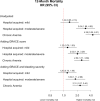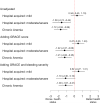Incidence, correlates, and outcomes of acute, hospital-acquired anemia in patients with acute myocardial infarction
- PMID: 20488919
- PMCID: PMC3384714
- DOI: 10.1161/CIRCOUTCOMES.110.957050
Incidence, correlates, and outcomes of acute, hospital-acquired anemia in patients with acute myocardial infarction
Abstract
Background: Anemia is common among patients hospitalized with acute myocardial infarction and is associated with poor outcomes. Less is known about the incidence, correlates, and prognostic implications of acute, hospital-acquired anemia (HAA).
Methods and results: We identified 2909 patients with acute myocardial infarction who had normal hemoglobin (Hgb) on admission in the multicenter TRIUMPH registry and defined HAA by criteria proposed by Beutler and Waalen. We used hierarchical Poisson regression to identify independent correlates of HAA and multivariable proportional hazards regression to identify the association of HAA with mortality and health status. At discharge, 1321 (45.4%) patients had HAA, of whom 348 (26.3%) developed moderate-severe HAA (Hgb <11 g/dL). The incidence of HAA varied significantly across hospitals (range, 33% to 69%; median rate ratio for HAA, 1.13; 95% confidence interval, 1.07 to 1.23, adjusting for patient characteristics). Although documented bleeding was more frequent with more severe HAA, fewer than half of the patients with moderate-severe HAA had any documented bleeding. Independent correlates of HAA included age, female sex, white race, chronic kidney disease, ST-segment elevation myocardial infarction, acute renal failure, use of glycoprotein IIb/IIIa inhibitors, in-hospital complications (cardiogenic shock, bleeding and bleeding severity), and length of stay. After adjustment for GRACE score and bleeding, patients with moderate-severe HAA had higher mortality rates (hazard ratio, 1.82; 95% confidence interval, 1.11 to 2.98 versus no HAA) and poorer health status at 1 year.
Conclusions: HAA develops in nearly half of acute myocardial infarction hospitalizations among patients treated medically or with percutaneous coronary intervention, commonly in the absence of documented bleeding, and is associated with worse mortality and health status. Better understanding of how HAA can be prevented and whether its prevention can improve patient outcomes is needed.
Figures





Comment in
-
Outcomes research: the next generation.Circ Cardiovasc Qual Outcomes. 2010 Jul;3(4):335-6. doi: 10.1161/CIRCOUTCOMES.110.957662. Circ Cardiovasc Qual Outcomes. 2010. PMID: 20647574 No abstract available.
References
-
- Vaglio J, Safley DM, Rahman M, Kosiborod M, Jones P, Thompson R, Krumholz HM, Spertus JA. Relation of anemia at discharge to survival after acute coronary syndromes. The American journal of cardiology. 2005;96(4):496–499. - PubMed
-
- Wu WC, Rathore SS, Wang Y, Radford MJ, Krumholz HM. Blood transfusion in elderly patients with acute myocardial infarction. The New England journal of medicine. 2001;345(17):1230–1236. - PubMed
-
- Nikolsky E, Aymong ED, Halkin A, Grines CL, Cox DA, Garcia E, Mehran R, Tcheng JE, Griffin JJ, Guagliumi G, Stuckey T, Turco M, Cohen DA, Negoita M, Lansky AJ, Stone GW. Impact of anemia in patients with acute myocardial infarction undergoing primary percutaneous coronary intervention: analysis from the Controlled Abciximab and Device Investigation to Lower Late Angioplasty Complications (CADILLAC) Trial. Journal of the American College of Cardiology. 2004;44(3):547–553. - PubMed
-
- Sabatine MS, Morrow DA, Giugliano RP, Burton PB, Murphy SA, McCabe CH, Gibson CM, Braunwald E. Association of hemoglobin levels with clinical outcomes in acute coronary syndromes. Circulation. 2005;111(16):2042–2049. - PubMed
-
- Anker SD, Voors A, Okonko D, Clark AL, James MK, von Haehling S, Kjekshus J, Ponikowski P, Dickstein K. Prevalence, incidence, and prognostic value of anaemia in patients after an acute myocardial infarction: data from the OPTIMAAL trial. European heart journal. 2009;30(11):1331–1339. - PubMed
Publication types
MeSH terms
Substances
Grants and funding
LinkOut - more resources
Full Text Sources
Medical

